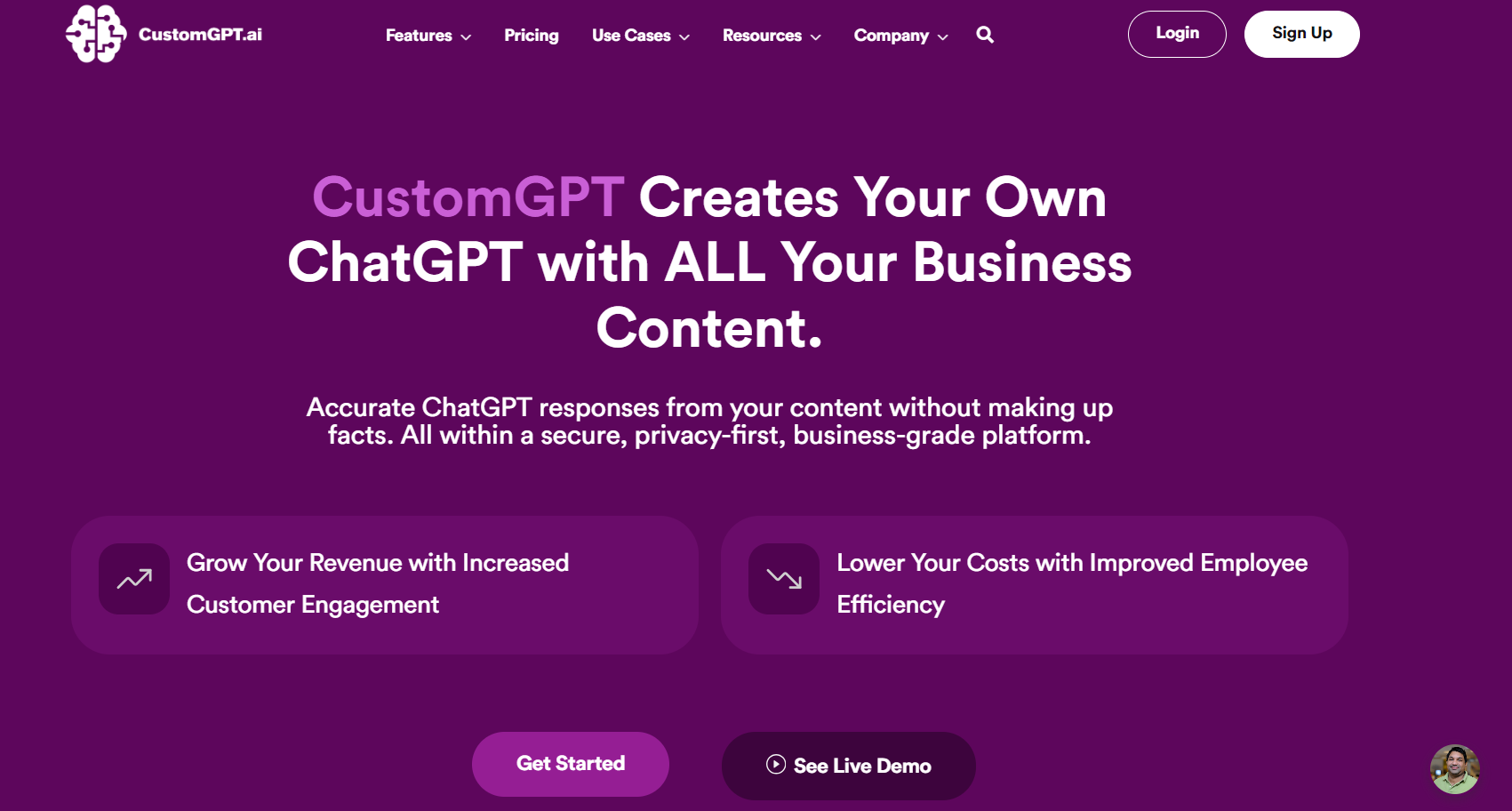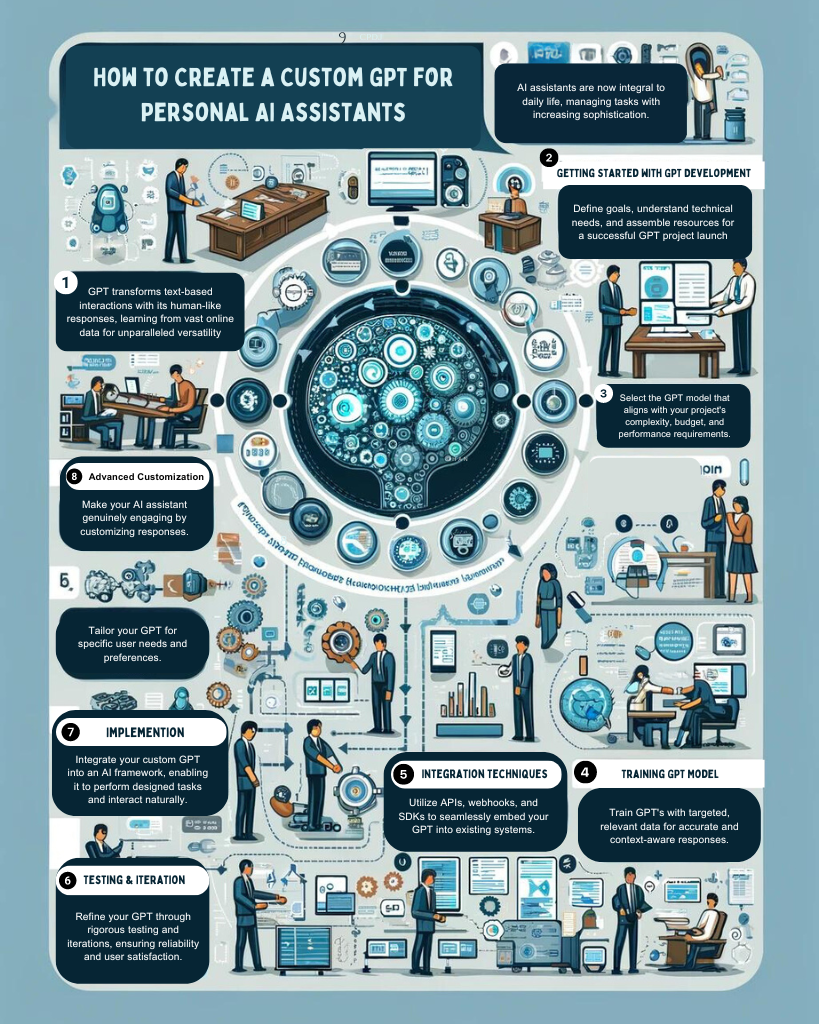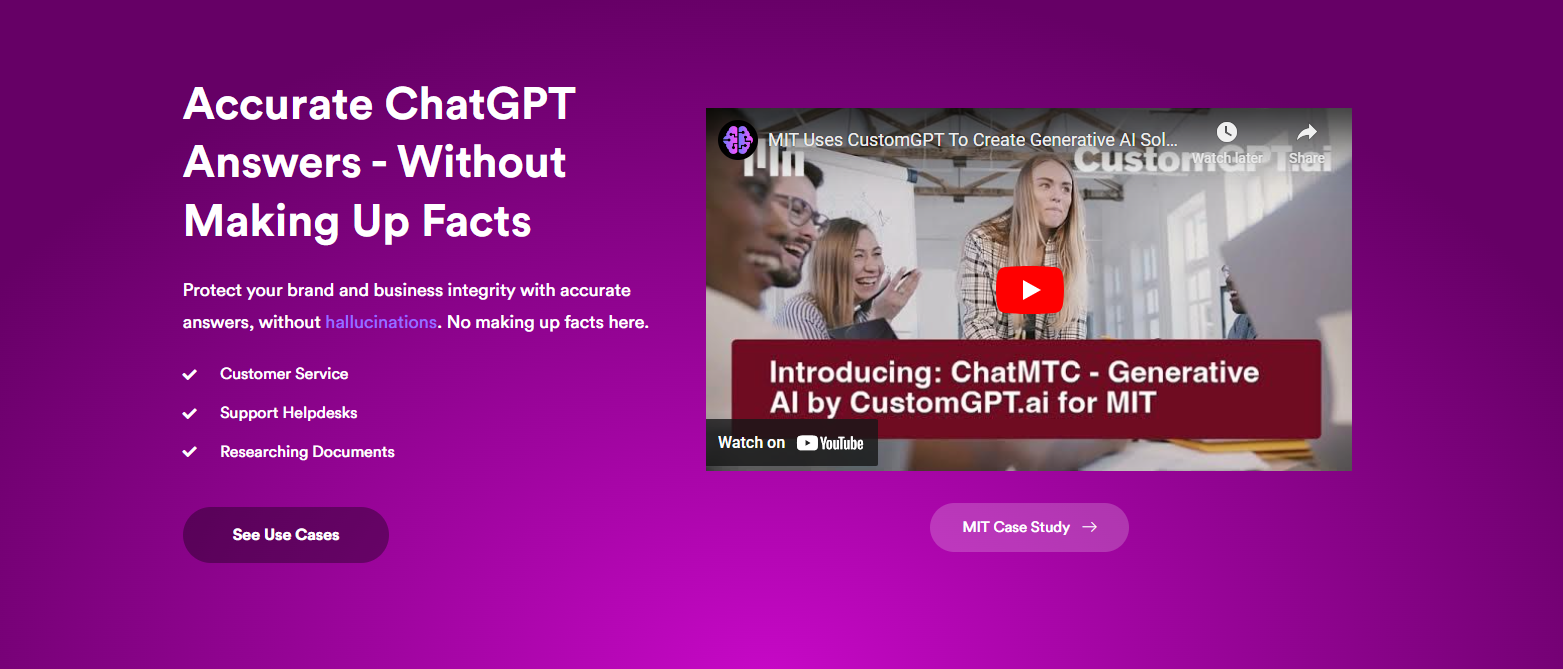
Imagine you’re at a bustling coffee shop, trying to order your favorite latte, but instead of a barista, there’s an AI assistant ready to take your order. This isn’t a scene from a sci-fi movie; it’s a glimpse into the potential future powered by custom GPTs.
Personal AI assistants are no longer just about setting reminders or playing your favorite songs. They’re evolving into highly personalized helpers, capable of understanding and executing tasks with a level of customization that feels almost human.
Creating a custom GPT for your personal AI assistant can transform it from a simple gadget into a powerful tool that understands your needs, preferences, and even your quirks.
This blog post will guide you through the journey of creating a custom GPT that can make your personal AI assistant truly yours, making your life easier, more efficient, and a lot more interesting.

The Rise of Personal AI Assistants
Once upon a time, the idea of talking to a machine seemed like pure science fiction. Fast forward to today, and personal AI assistants are becoming as common as smartphones. It’s fascinating how quickly they’ve woven into the fabric of our daily lives.
From setting alarms to managing our homes, these digital helpers are getting smarter by the day. What’s driving this surge? It’s simple: our hunger for convenience and efficiency. We’re always looking for ways to do things quicker, better, and with less effort.

Personal AI assistants, powered by advancements in AI and machine learning, are stepping up to the plate.
They’re not just tools; they’re becoming our companions, making the digital world a lot more personal and accessible. It’s a thrilling time, and we’re just scratching the surface of what’s possible.
Understanding GPT and Its Capabilities
GPT, or Generative Pre-trained Transformer, sounds like something out of a sci-fi novel, doesn’t it? But in reality, it’s a game-changer in the world of AI.
Picture this: an AI that can chat, write, and even create content that feels like it was made by a human. That’s GPT for you. It’s like having a Swiss Army knife for digital tasks.

Whether you need an email drafted, a blog post written, or just want to shoot the breeze with a digital buddy, GPT has got your back. The beauty of it? It learns from the vast ocean of data on the internet, which means it’s always getting smarter.
So, when we talk about creating a custom GPT for personal AI assistants, we’re tapping into this powerhouse of versatility and intelligence. Exciting, right?
Getting Started with GPT Development
Diving into the world of GPT development can feel like standing at the edge of a vast, unexplored ocean. It’s thrilling, a bit intimidating, but mostly, it’s packed with potential. Remember the first time you tried to ride a bike?
There was that mix of excitement and a tiny bit of fear, right? That’s exactly how embarking on creating your custom GPT for a personal AI assistant feels. But here’s the kicker: once you get the hang of it, there’s no looking back.
The beauty of GPT development lies in its ability to transform raw data into something that feels almost human.
With tools like CustomGPT.ai, the process becomes less about coding complexities and more about shaping your AI assistant to understand and interact in ways that are uniquely tailored to you. So, let’s strap in and start this journey together, shall we?

Choosing the Right GPT Model
Embarking on the journey of GPT development feels a bit like picking the perfect ingredient for your secret recipe. It’s crucial, right? With options like GPT-3 and GPT-3.5 Turbo, the choice can seem overwhelming.
Think of GPT-3 as the powerhouse, perfect for tasks needing deep, nuanced understanding. It’s like the heavy-duty mixer in your kitchen arsenal.
On the flip side, GPT-3.5 Turbo offers a balance of performance and cost, akin to your reliable hand mixer that gets the job done efficiently. Your project’s scale, budget, and specific needs are your recipe guide here.
Opting for the right model is like choosing the right tool for your culinary masterpiece. It’s all about finding that sweet spot between performance and cost, ensuring your personal AI assistant is both brilliant and budget-friendly.
Setting Up Your Development Environment
Getting your development environment ready is like setting up your kitchen before you start cooking a new recipe.
First off, you’ll need Python installed – it’s the stove in our kitchen analogy. Then, gather the required libraries and dependencies, which are like your ingredients. Each GPT clone has its own recipe, so check the documentation or repository for the exact mix you’ll need.
It’s a bit like following a cooking show; you want to make sure you’ve got everything laid out before you start.
This prep work ensures that when you’re ready to dive into creating your custom GPT for personal AI assistants, everything runs as smoothly as a well-oiled machine. Trust me, a little setup now saves a ton of time later!

Designing Your Custom GPT
Imagine you’re an artist, but instead of paint and brushes, your tools are data and algorithms. That’s the essence of designing your custom GPT for personal AI assistants. It’s about crafting an AI that doesn’t just understand commands but gets you.
Whether you’re aiming to automate your daily tasks, enhance your productivity, or simply have a digital buddy to brainstorm ideas with, the design phase is where your vision starts to take shape.
This step is your blueprint, guiding you through the intricate process of turning what might seem like a far-fetched dream into a tangible, interactive assistant. So, let’s dive in and explore how you can design a GPT that’s not just smart, but also uniquely yours.

Defining the Scope and Functionality
When you’re diving into the world of custom GPTs, think of yourself as a chef in a gourmet kitchen. Your first step? Deciding what dish you’re going to whip up. This is exactly like defining the scope and functionality of your custom GPT.
Ask yourself, “What do I want my personal AI assistant to do?” Maybe you need it to manage emails, help with content creation, or even code. This step is crucial because it sets the direction for your project. It’s like picking a recipe before you start cooking.
Without this, you’re just throwing ingredients together and hoping for the best. So, take a moment to really think about what functionalities will make your life easier. This clarity will be your recipe for success.
Training Your GPT Model with Specific Data
Imagine you’re a chef, but instead of flavors, you’re mixing data to cook up the perfect AI assistant. Training your GPT model with specific data is like seasoning your dish to taste just right.
You start with the basics – your FAQs, customer support transcripts, or product details. This is your salt and pepper, giving the AI a base flavor of your business.
Then, you get creative, adding in unique datasets that make your AI truly yours, like a secret spice. This could be industry-specific reports or internal knowledge bases.
The goal? An AI that doesn’t just understand your business but gets it on a deeper level, ready to engage in meaningful conversations with your users. It’s a process, but when done right, the results are mouthwateringly good.
Implementing Your GPT in a Personal AI Assistant
Did you know that the right personal AI assistant can feel like having a superhero sidekick? That’s right! After designing your custom GPT, the next thrilling step is bringing it to life within a personal AI assistant.
This phase is where your creation starts interacting with the world, ready to tackle tasks, answer questions, and maybe even crack a joke or two. It’s like watching your favorite sci-fi movie become reality, right in your daily routine.
Implementing your GPT into a personal AI assistant isn’t just about technology; it’s about creating a companion that understands your needs and enhances your life.
So, let’s dive into how you can turn your custom GPT into your very own AI sidekick, making every day a bit more like the future.

Integration Techniques
So, you’ve got your custom GPT ready to roll. What’s next? It’s time to integrate it into your personal AI assistant. Think of this like fitting a powerful engine into a car. You need the right tools and techniques to ensure it runs smoothly.
First off, using APIs is like the nuts and bolts of this process. They help your GPT chat with other applications seamlessly. Then, consider webhook for real-time updates, making your AI assistant as responsive as a chat with a friend. Lastly, don’t forget about SDKs.
They’re like a custom toolkit, making sure your GPT fits perfectly into its new home. With these techniques, your personal AI assistant will not just be smart; it’ll be a genius, ready to tackle any task you throw its way.
Testing and Iteration
Once you’ve nestled your custom GPT into its new home within your personal AI assistant, it’s time to roll up your sleeves for some testing and iteration. Think of this phase as a dress rehearsal before the big show.
You start by throwing different types of questions and tasks at it, just to see how well it performs. It’s a bit like a taste test; sometimes, the flavor is just right, and other times, you’ll need to go back to the kitchen.
This step is crucial because it’s where you fine-tune your AI, making sure it’s not just smart, but also practical and helpful.
Remember, the goal is to create an assistant that doesn’t just understand your commands but also executes them flawlessly. So, take your time, be thorough, and don’t shy away from multiple iterations. After all, perfection is a journey, not a destination.
Advanced Customization and Optimization
Ever stumbled upon a tool or app and thought, “This is great, but I wish it could do this specific thing”? That’s the moment when the magic of advanced customization and optimization comes into play, especially when creating your personal AI assistant.
It’s like having a secret sauce that transforms a good dish into an unforgettable meal.
By diving deep into the customization options, you can tailor your GPT to understand not just the words you say, but the intent behind them, making your interactions smoother and more intuitive.
And with optimization, it’s all about fine-tuning performance to ensure your AI assistant responds quickly, accurately, and in a way that feels uniquely yours.
Let’s explore how you can elevate your custom GPT from standard to spectacular, ensuring it not only meets but exceeds your expectations.

Fine-Tuning for Performance
When it comes to making your personal AI assistant as sharp as a tack, fine-tuning is where the magic happens. Imagine you’re sculpting a masterpiece. Initially, it’s all rough and general.
But with fine-tuning, you start chiseling away, defining those features until it’s exactly what you envisioned. That’s what we’re doing here. We’re tweaking and adjusting your custom GPT to ensure it responds not just accurately, but lightning fast.

It’s about making sure your AI assistant doesn’t just understand you, but gets you. This process might involve a bit of trial and error, but hey, that’s the beauty of creation.
By focusing on performance, we’re ensuring your AI assistant isn’t just functional; it’s exceptional.
Personalization Strategies
Diving into the world of custom GPT for your personal AI assistant, it’s like tailoring a suit. It needs to fit perfectly. Personalization is key. You start by understanding the unique needs and preferences of your users.
It’s not just about knowing their names but understanding their habits, preferences, and even the nuances of their requests. With CustomGPT.ai, you can leverage its no-code visual builder to craft responses that feel personal and engaging.
Imagine an AI that not only knows what your users like but also how they speak. By incorporating elements such as user data and specific interaction patterns, you create an assistant that’s not just smart but also incredibly personal.
This approach transforms interactions from generic to genuinely engaging, making every user feel like the AI truly gets them.

FAQ
1. How can I integrate domain-specific knowledge into my custom GPT?
Integrating domain-specific knowledge into your custom GPT is a game-changer for creating a personalized AI assistant that truly understands your needs or the unique requirements of your business. Here’s how you can do it:
- Identify Your Domain: Start by pinpointing the specific domain or industry your custom GPT will focus on. This could be anything from healthcare, finance, to culinary arts. Understanding the domain helps in gathering the right data and tailoring the AI’s responses.
- Collect Data: Gather comprehensive data within your chosen domain. This includes articles, reports, manuals, and any other relevant information that can provide your GPT with the knowledge it needs. The more specific and high-quality your data is, the better your GPT will perform.
- Use a GPT Builder: Platforms like CustomGPT.ai offer no-code visual builders that allow you to easily upload your domain-specific data. This process enables the AI to learn from this data, making it adept at handling queries related to your specific domain.
- Train and Test: After uploading your data, train your custom GPT model. It’s crucial to test it with real-world queries to ensure it accurately understands and responds based on the domain-specific knowledge it has learned.
- Iterate: Based on the testing feedback, make necessary adjustments. This might involve adding more data, tweaking the model, or refining the types of queries it can handle. Continuous iteration helps in enhancing the accuracy and relevance of the AI’s responses.
By following these steps, you can successfully integrate domain-specific knowledge into your custom GPT, creating a powerful and personalized AI assistant that excels in your chosen domain.
2. What are the best practices for optimizing the performance of a custom GPT AI assistant?
Optimizing the performance of a custom GPT AI assistant involves several key practices that ensure it meets and exceeds user expectations. Here are some best practices to consider:
- Define Clear Objectives: Start by setting clear goals for what you want your custom GPT AI assistant to achieve. Whether it’s improving customer service response times, providing more accurate information, or handling a higher volume of queries, having specific objectives will guide your optimization efforts.
- Train with Relevant Data: The quality of responses from your AI assistant depends heavily on the data it’s trained on. Integrate a comprehensive knowledge base that includes domain-specific information, FAQs, and scenarios that your assistant is likely to encounter. This ensures your assistant is well-equipped to handle a wide range of queries.
- Implement Continuous Feedback Loops: User feedback is invaluable for improving your AI assistant. Implement mechanisms to collect and analyze feedback on the assistant’s performance. Use this data to make iterative improvements, refining responses and expanding the knowledge base as needed.
- Monitor Performance Metrics: Keep an eye on key performance indicators such as response times, resolution rates, and customer satisfaction scores. These metrics will help you identify areas where your assistant excels and where there’s room for improvement.
- Ensure seamless integration: Your custom GPT AI assistant should integrate smoothly with existing platforms and systems. This ensures a consistent user experience across all channels and allows the assistant to access necessary information to provide accurate responses.
- Prioritize Security and Privacy: Ensure that your AI assistant adheres to data protection regulations and maintains user privacy. This builds trust and ensures that sensitive information is handled appropriately.
By following these best practices, you can optimize the performance of your custom GPT personal AI assistants, making it a valuable asset for your organization or personal use.
3. Can I customize the tone and style of my personal AI assistant using custom GPT?
Absolutely! Customizing the tone and style of your personal AI assistant is one of the key features of using a custom GPT. With platforms like CustomGPT.ai, you have the power to tailor your AI assistant’s responses to match the specific voice and style you desire.
This means you can make your AI sound professional, friendly, or even quirky, depending on your needs.CustomGPT.ai offers a range of customization options, including prompt text customization and language customization.
This flexibility allows you to create an AI assistant that not only understands your specific requirements but also communicates in a way that aligns with your brand or personal preferences. Whether you’re aiming for a tone that’s formal, casual, or somewhere in between, CustomGPT.ai makes it possible to achieve the perfect style for your AI assistant.
4. What are the challenges in maintaining privacy and security while using custom GPT for personal AI assistants?
Creating a custom GPT for personal AI assistants brings forth a unique set of challenges, especially when it comes to maintaining privacy and security. Here’s a breakdown of these challenges:
- Data Privacy: When you feed your data into the chatbot knowledge base to train your custom GPT, you’re essentially giving it access to potentially sensitive information. This raises concerns about data collection practices and privacy protection. Ensuring that this data doesn’t get misused or fall into the wrong hands is a primary challenge.
- Security Risks: Without proper cybersecurity measures, there’s a risk that private or sensitive information could be exposed to unauthorized users. The challenge here is implementing robust security protocols to safeguard this data against breaches or unauthorized access.
- Bias and Inaccuracies: Another challenge is the potential for bias and inaccuracies in the responses generated by the chatbot. If the chatbot produces information that’s not accurate or relevant to the provided data, it can erode user trust and damage the credibility of the source. Addressing these issues is crucial for maintaining the integrity of the AI assistant.
- Jailbreaking Vulnerabilities: CustomGPT faces the challenge of jailbreaking – where users manipulate AI chatbots to bypass ethical constraints. This not only poses a risk to the integrity of the AI system but also to the security of user information. Ensuring that the system is fortified against such vulnerabilities is essential for protecting sensitive data.
CustomGPT.ai addresses these challenges head-on by implementing strong encryption, strict access controls, and anti-hallucination technology. These measures ensure that your data remains secure, protected, and accurately represented, making CustomGPT.ai a reliable choice for creating personal AI assistants with a focus on privacy and security.
Conclusion
Did you know that the journey to creating your very own custom GPT for a personal AI assistants is akin to crafting a masterpiece? It’s true!
Just like an artist who meticulously chooses their palette to bring their vision to life, you’ve navigated through the complexities of customization, data privacy, and user experience.
Now, as we draw the curtains on this guide, it’s time to reflect on the adventure we’ve embarked upon together. From the initial spark of curiosity to the final touches that make your AI assistant uniquely yours, every step has been a leap towards innovation.
Let’s take a moment to appreciate the artistry behind the technology and envision the endless possibilities that your custom GPT for personal AI assistants holds for the future.

The Future of Personal AI Assistants
The future of personal AI assistants looks incredibly bright, and it’s not just about the cool tech. Imagine having a buddy who not only gets your taste in music but also drafts emails and manages your schedule without breaking a sweat. That’s where we’re headed.
With tools like CustomGPT.ai, creating an AI that feels more like a personal sidekick than a tool is becoming a reality. It’s about making technology so seamless and personalized that it feels like an extension of ourselves.
So, as we look forward, the line between human and AI interaction is not just blurring; it’s disappearing. And that, my friends, is a future worth getting excited about.
- Creating a Custom GPT for Hobbyists: Photography, Painting, and More - March 21, 2024
- Developing a Tailored GPT Model for Blockchain and Cryptocurrency Education - March 21, 2024
- Customizing a GPT for Automotive Maintenance and Car Buying Advice - March 21, 2024




